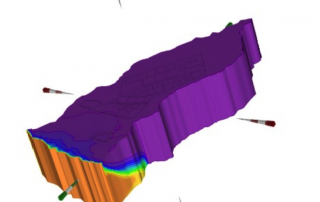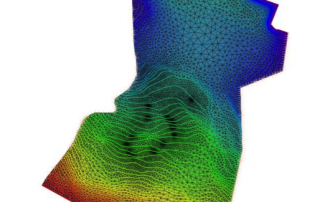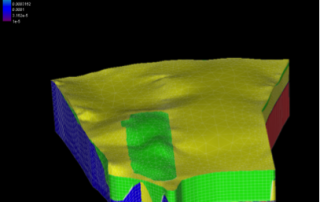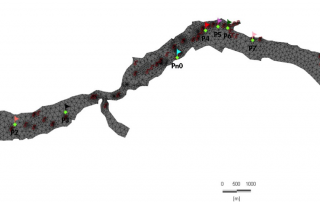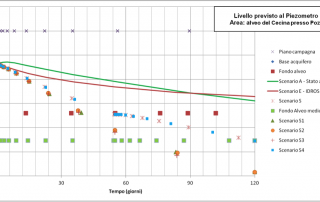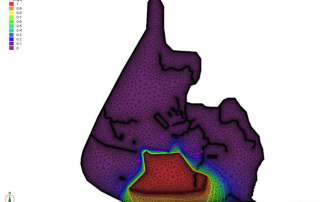Understanding groundwater flow is key of several fields of applications, including underground excavations, reclamation of contaminated sites including pump and treat systems, confinement of hazardous waste and landfills, design of wells and protection of groundwater resources.
GECOsistema’s experience in groundwater flow and solute transport is based on a long list of projects undertaken in several hydrogeological contexts in Italy and other countries. We have tackled confined and unconfined problems in riverine alluvial fans, moderate and low permeability sedimentary bodies, coastal aquifers, fractured systems, and artificial porous media such as debris and waste deposits.
GECOsistema has extensive experience on all aspects of groundwater flow and solute transport modeling:
- collection and analysis of field data, interpretation of pumping tests, slug tests and laboratory tests;
- conceptual site modeling on the basis of litho-stratigraphic, hydro-geochemical and geophysical (seismic, aeromagnetic, geoelectrical) information;
- compilation of the aquifer water budget and estimation of groundwater recharge;
- calibration and validation of advanced numerical models of soil- and groundwater systems including saltwater ingression, the vadose zone and preferential flows in fractures and cracks, and interaction between surface- and groundwater bodies;
- use of model sensitivity analysis for the quantification of structural and parameter uncertainty of groundwater models;
- modeling of solute transport in complex field flows, including retardation, degradation and volatilization;
- modeling of multiphase flows and non-aqueous phase liquids (NAPLs) including percolation through the vadose zone, buoyancy of oil lenses, and transport of the soluble components.
For general problems requiring complex numerical modeling, GECOsistema masters the three-dimensional finite element model FEFLOW and the popular quasi-3D finite difference model MODFLOW together with the chemical transport model MT3D.
These models enable a full description of virtually all aspects of groundwater flow and transport in porous and fractured media. While FEFLOW solves saturation-dependent, density dependent flow equations with different numerical methods, MODFLOW is generally limited to saturated, density-independent problems.
Additional models routinely used by GECOsistema include USGS’ VS2D and SUTRA. For several problems concerning soil and groundwater chemical pollution, when site characterization is limited and for screening purposes, we often use VLEACH for the fate and transport of organic contaminants, and the Hydrocarbon Spill Screening Model (HSSM) by USEPA.
A special class of models that we use for regional scale problems and for the evaluation of wellhead protection areas is that of analytic element models among which, particularly, USEPA’s WhAEM
The purpose of the assessment is to ensure that decision makers consider the environmental impacts when deciding whether or not to proceed with a project. The International Association for Impact Assessment (IAIA) defines an environmental impact assessment as “the process of identifying, predicting, evaluating and mitigating the biophysical, social, and other relevant effects of development proposals prior to major decisions being taken and commitments made.”[1]
EIAs are unique in that they do not require adherence to a predetermined environmental outcome, but rather they require decision makers to account for environmental values in their decisions and to justify those decisions in light of detailed environmental studies and public comments on the potential environmental impacts.
Strategic environmental assessment (SEA) is a systematic decision support process, aiming to ensure that environmental and possibly other sustainability aspects are considered effectively in policy, plan and programme making. In this context, following Fischer (2007)[1] SEA may be seen as:
- a structured, rigorous, participative, open and transparent environmental impact assessment (EIA) based process, applied particularly to plans and programmes, prepared by public planning authorities and at times private bodies,
- a participative, open and transparent,possibly non-EIA-based process, applied in a more flexible manner to policies, prepared by public planning authorities and at times private bodies, or
- a flexible non-EIA based process,applied to legislative proposals and other policies, plans and programmes in political/cabinet decision-making.
Effective SEA works within a structured and tiered decision framework,aiming to support more effective and efficient decision-making for sustainable development and improved governance by providing for a substantive focus regarding questions, issues and alternatives to be considered in policy, plan and programme(PPP) making.
SEA is an evidence-based instrument, aiming to add scientific rigour to PPP making, by using suitable assessment methods and techniques.
From 2005-2007, the effect of the directive was assessed. In 2010, a revised wording was published, integrated with 6 other European directives regulating large industrial sites, into the Industrial Emissions Directive, short IED.

